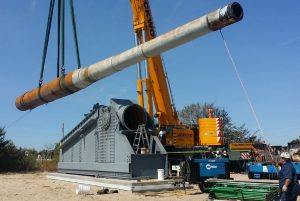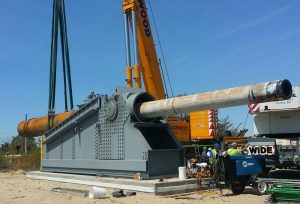Upgrades expected to bring in additional campers; generate more funding for DE State Parks
BEAR – Governor Jack Markell, DNREC Deputy Secretary Kara Coats, EPA Regional Administrator Shawn M. Garvin, state legislators, and other partners and stakeholders were on hand today to welcome visitors to the reopening of the newly transformed campground at Lums Pond State Park.
With annual camping numbers at record highs, DNREC’s Division of Parks & Recreation has added key infrastructural improvements and amenities to the park, which are designed to draw new campers to the only campground in New Castle County.
Delaware State Parks served a record number of campers and cabin guests in 2015, higher than at any other time in parks’ history, with a 19 percent increase over 2014. Parks officials expect the improvements at Lums Pond State Park will draw hundreds of new campers to help boost those numbers even higher in 2016.
“This is great news for campers and the strategic location, close to I-95 and Route 40, makes it a great stop for travelers headed to the beaches and other vacation destinations,” said Gov. Jack Markell. “The success of this campground is good for tourism, for our economy and for the enjoyment of the people of this state. This project is an investment that will bring more visitors to the state and support the many jobs and businesses in the area.”
Major improvements to the expanded, 70-site RV campgrounds include three-point hookups that provide water, sewer and 50-amp electrical service to the campsites – three of which are also fully-accessible – and paving of all of the sites. Other improvements include a new bathhouse and five new walk-in tent sites.
As the only state park campground in New Castle County, the Lums Pond State Park campground is expected to become a major attraction with amenities that include an extensive trail system and the Go Ape high adventure zipline course. It is close to many other Brandywine Valley attractions and serves as the official campground of the University of Delaware. The closest state parks campgrounds with similar amenities are more than an hour away.
“Lums Pond State Park is a must- see for visitors in and outside of Delaware,” said DNREC Deputy Secretary Kara Coats. “The improvements to the campground showcase the park as a major Delaware camping destination. The investment made by federal, state and local partnerships will enable hundreds of additional families to enjoy the camping options that this marvelous park offers.”
The campground improvements are projected to generate more than $300,000 for state parks in 2017. That’s more than double the current revenue, all of which helps support state parks’ 65-percent self-funded business model. The revenue will enable the Division to make payments on the loan funding.
The campground has been closed all winter for the $5.6 million renovation, funded through the Clean Water State Revolving Loan Fund, the federal-state partnership that provides low-cost financing for a wide range of water quality infrastructure projects. The program is funded by annual Environmental Protection Agency capitalization grants and the required 20 percent state matching funds appropriated through the state Bond Bill.
“These park upgrades, aided by EPA’s State Revolving Fund, will provide the infrastructure improvements that enable more visitors to enjoy the many environmental amenities that Lums Pond State Park has to offer,” said EPA Regional Administrator Shawn M. Garvin. “Delaware’s decision to expand and improve the facilities at this park will greatly improve the outdoor experience for the many visitors, especially the campers.”
“Delaware is a destination for its world-class beaches and tax-free shopping, but it also has beautiful parks and recreational amenities for residents and visitors alike,” said U.S. Sen. Tom Carper. “By utilizing a federal assistance program like this one, the state has improved one of its most popular recreational attractions that will prove to be not only a wonderful upgrade for those who visit, but an economic driver for the state as well.”
“Our family loves Delaware’s great state parks, and we’re lucky to have such a great park system in the First State,” said U.S. Senator Chris Coons. “When asked about the quality of life where they live, people invariably mention the quality and character of parks, and this investment into Lums Pond State Park’s new amenities will draw campers and outdoor enthusiasts to this location and will entice past campers to return. I want to thank and congratulate Governor Markell and the EPA for the new additions that will only serve to compliment the beauty and accessibility of Lums Pond State Park.”
“Summer’s in full swing,” said Congressman John Carney. “We’re expecting a record number of campers visiting Delaware State Parks this year, including at the newly renovated campground at Lums Pond. We have some of the most beautiful and fun campgrounds in the area, and I’m glad Delawareans will get to enjoy camping at Lums Pond once again! Our parks are an important part of the state’s tourism economy, and great places for Delawareans and visitors to enjoy.”
“We had to get creative to make this project happen,” said Delaware State Parks Director Ray Bivens, “to find a funding source that hadn’t been used for this purpose before. Some of the improvements we see today were identified as far back as the 1970s, but were never funded until now. There is already a tremendous amount of excitement about the improvements from the camping community. We know that adding utilities and other amenities could draw thousands of new visitors to the park. In fact, the campground is completely booked for the upcoming weekend.”
“Tourism is a major economic driver for our state, and knowing that camping numbers are at record highs means that this is a smart investment for our state,” said House Majority Leader Valerie Longhurst, whose district borders the park. “By making these upgrades, we are making Lums Pond more inviting and more attractive for new visitors and encouraging new campers to stay here.”
“Lums Pond is one of the 12th District’s true jewels – an amazing oasis for recreation in our most populous county,” said Sen. Nicole Poore. “This new campground will allow new visitors from Delaware and beyond to discover this jewel and all it has to offer to families and those who love the outdoors.”
“There are a lot of great activities that draw visitors to Lums Pond: hiking, biking and horse-riding, trails, boating opportunities, and of course, the Go Ape zipline course,” said Rep. Earl Jaques, whose district includes the park. “These improvements to our campgrounds will make visitors feel more welcome. We want everyone to enjoy their stay here, and I believe DNREC has done a great job with these amenities to make sure all campers have a great time and then come back and visit us again.”
Other key campground improvements include:
- A brand new heated and fully-accessible bathhouse that includes four showers, four family bathrooms with showers, and standard toilet facilities.
- A modernized lift station to manage additional wastewater. The lift station pumps wastewater to the sewage treatment plant.
- Grouted manholes to prevent any environmental contamination.
- An environmentally-friendly pervious parking lot for tent campers, with a five-car capacity.
Media Contact: Beth Shockley, DNREC Public Affairs, 302-739-9902
Vol. 46, No.218


